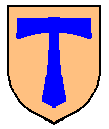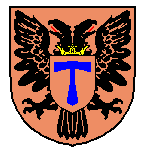The Double-Headed Eagle of the Order Saint John of Jerusalem, Knights Hospitaller pre 1798.
Copyright © The Rev'd Dr Michael Foster SSC MIWO
The double headed eagle, which provided a supporter for the arms of the Order under Grand Master Paul I, was not an innovation as some might believe. The original form of the Double-headed eagle was Austrian and had been in use from 1778 to 1798, and had resulted from the absorption of the Order of St Anthony into that of St John, which itself had used the Austrian Eagle. The precedent for Paul had been set by the Order before he became a Protector, or its Grandmaster. All that Paul I did, was to replace the eagle of the Holy Roman/Austrian Empire, with that of the Empire of Russia.
 This
Hospitaller Order of St Anthony (not an Order of Knights but a non-military
Monastic Order) was founded at La Motte in the Dauphine of France in 1095
by Gaston, a nobleman, whose son was struck by a fungal disease, known in
the Middle Ages as Saint Anthony's fire (ergotism). This disease is caused
by a transformation of the grain (often rye) into enlarged, hard, brown to
black spur-like structures that constitute the source of the drug ergot in
flour and causes convulsions often leading to death. (In Dutch:
moederkoornvergiftiging; in German: Mutterkornvergiftigung; in Swedish: mjoldryka
and in Finnish: torajyva).
This
Hospitaller Order of St Anthony (not an Order of Knights but a non-military
Monastic Order) was founded at La Motte in the Dauphine of France in 1095
by Gaston, a nobleman, whose son was struck by a fungal disease, known in
the Middle Ages as Saint Anthony's fire (ergotism). This disease is caused
by a transformation of the grain (often rye) into enlarged, hard, brown to
black spur-like structures that constitute the source of the drug ergot in
flour and causes convulsions often leading to death. (In Dutch:
moederkoornvergiftiging; in German: Mutterkornvergiftigung; in Swedish: mjoldryka
and in Finnish: torajyva).
The members of this Order specialised in curing patients suffering from this disease, hence the name Saint Anthony's fire. The Order originally consisting of laymen, was approved by Pope Urban II during the Council of Clermont in 1095. Later in 1218, Pope Honorius III permitted the brothers to take the vows of obedience, poverty and chastity. In the thirteenth century the Order spread over the whole of Western Europe with about 370 hospitals.
 Because
of the wars and disorder during the Reformation the monasteries and hospitals
of the Order were often confiscated or destroyed. The attempt of their Grand
Master in 1630 to reform the Order was not a success. In 1775 Pope Pius VI
incorporated the Order into the Order of Saint John of Jerusalem.
Because
of the wars and disorder during the Reformation the monasteries and hospitals
of the Order were often confiscated or destroyed. The attempt of their Grand
Master in 1630 to reform the Order was not a success. In 1775 Pope Pius VI
incorporated the Order into the Order of Saint John of Jerusalem.
The coat of arms of the Hospitallers of Saint Anthony was; Or a Tau-Cross Azure which the members of the Order wore on their black cloak.
In 1502 the Austrian Emperor Maximilian I granted the Austrian double-headed eagle as an augmentation to their coat of arms, placed behind the Tau-Cross When the Order was amalgamated with the Order of Saint John of Jerusalem this double-headed eagle was placed as a supporter behind the coat of arms of the latter Order and also behind that of the Grand Master.
 In 1778,
three years after the amalgamation of the Order of Saint Anthony with the
Order of Saint John of Jerusalem, Grand Master Rohan placed Order's arms
upon the Austrian double-headed eagle. On this Gold Coin from Grand Master
Rohan's time which dates to 1778, the eagle holds a Tau-Cross in both beaks.
In 1778,
three years after the amalgamation of the Order of Saint Anthony with the
Order of Saint John of Jerusalem, Grand Master Rohan placed Order's arms
upon the Austrian double-headed eagle. On this Gold Coin from Grand Master
Rohan's time which dates to 1778, the eagle holds a Tau-Cross in both beaks.
The correct eagle for the pre 1798 period is all black with a red tongue. It follows that golden beaks and claws, red beaks and claws and white feathers amongst the black are inappropriate and historically incorrect. Late 1798 the Austrian Eagle had been replaced by the Russian Eagle.

The last time the Order used the Austrian Eagle as a supporter was under Ferdinand von Hompesch in 1798. Following the disgrace of Hompesch and the election of Paul I (initially schismatically) to the Grandmastership of the Order, the Austrian Eagle was replaced by the Russian Eagle, and in addition to the plain white greek cross on a red shield, the Maltese Cross was placed behind the shield.
Following the transfer of the Grand Magistracy to Roman Catholic control in 1803, the Russian Arms ceased to be the Official ARms of the Order. However the Russian Grand Priory continued with the Arms as given by Emperor Paul I. The exilic Grand Priory, which was given a formal existence by the Russian Commanders of Family meeting at Paris in 1928, provided a description of the Arms in the Constitution framed in 1953;
ART. 11. Les armoiries du Grand Prieuré Russe représentant le blason octroyé au Prieuré par le Grand Maître de l'Ordre Souverain de Saint-Jean de Jérusalem et Empereur de toutes les Russies, Paul Ier l'Aigle bicéphale de Russie avec la Croix de Malte blanche à huit pointes sur son poitrail portant l'antique écu militaire de cet Ordre à la Croix pleine blanche sur champ de gueules (rouge).
Les principaux actes du Grand Prieuré Russe sont timbrés de ce blason, dont se sert également son Grand Prieur (ou Protecteur). Le blason ordinaire du Grand Prieuré est la double Croix de Malte décrite ci-dessus.
ART. 12. L'insigne dont peuvent se servir et le porter sur le côté gauche de la poitrine les membres du Grand Prieuré est la Croix de Malte blanche à huit pointes avec un écusson d'or le superposé portant l'Aigle Noire bicéphale de Russie.
In English Translation;
ART. 11. The coat of arms of Russian Grand Priory representing the blason granted to the Priory by the Grand Master of the Sovereign Order of Saint-John of Jerusalem and Emperor of all Russias, Paul I, The two headed Eagle of Russia with the white Cross of Malta with eight points on its breast carrying the antique military shield of this Order with a plain white Cross on a field of gules (red).
The principal acts of Russian Grand Priory are stamped with this blason, which equally serves the Grand Prior (or Protector). The ordinary blason of Grand Priory is the double Cross of Malta described above.ART. 12. The insignia which can serve and to be worn on the left side of the chest of the members of Grand Priory is the white Cross of Malta with eight points with a gold shield superimposed carrying the Black double-headed Eagle of Russia.
© The Reverend Dr. Michael Foster SSC. MIWO.
Source of information on the Hospitaller Order of St Anthony was supplied from; Caluwé, The Reverend Robert de. Guide notes on Heraldry of the Sovereign Order of Saint John of Jerusalem Knights Hospitaller, OSJ ivzw Belgium, 2000, pages 42 & 43.
Home Page on this Web Site
![]()
![]()

![]() This
way to the Main Research Web Site
This
way to the Main Research Web Site